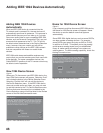48
IEEE 1394 Devices Compatibility
1. Digital Video Signals
The TV is able to decode MPEG2 video. Other types
of digital video, such as DV video provided by some
camcorders, must be decoded by the source device
and sent to the TV as analog video or S-Video. If the
camcorder uses a compatible digital control system,
the IEEE 1394 cable can still provide control for the
camcorder while the TV is viewing the analog video or
S-Video signals.
2. Digital Audio Signals
When received with video signals, the TV is able to
decode Dolby Digital signals and MPEG Audio signals.
Other types of digital audio as provided by some digital
recording devices, such as MP3 Audio and DTS Audio,
cannot be decoded by the TV when received over IEEE
1394.
The TV may not be able to pass incompatible digital
audio signals on the coaxial digital audio output,
however these signals may pass on the IEEE 1394
cable to other devices.
3. Digital Control Signal
The TV is able to act as the control center for IEEE 1394
audio/video devices, such as VCRs, A/V Discs, tuners,
cable boxes and amplifiers that are compatible with the
following IEEE 1394 control standards.
• EIA-775 is designed for tuning devices such as
cable boxes allowing the device to send simple
graphics. However, this standard does not allow
the TV to control the cable box by IEEE 1394.
• AV/C (Audio Video Control) is designed to
provide basic controls such as play, stop,
channel selection and volume, as appropriate
for the device. Some devices may have an on-
screen display for these functions.
Some devices may be a combination of two or more
types of devices. For example, there may be a
recording device that is also a tuning device. Each
portion of the device is called a sub-unit. When you
select a device on the Device Selection menu that has
sub-units, a pop-up menu will appear so you can select
which sub-unit section you wish to use.
The TV is not able to control IEEE 1394 devices that use
other types of control protocols. Incompatible digital
audio, video and/or control information will still be able
to pass from one device through the TV to another
Compatible IEEE 1394 Devices
It is possible to connect devices to the TV that have IEEE 1394 connectors but are not compatible with the TV or with
the NetCommand
®
control system. Areas of compatibility to consider are:
device on the network. These incompatible devices
may not appear on the Device Selection menu or in the
Review screen of the Edit NetCommand menu.
NetCommand Control of Digital
Devices Using the “Learn” Feature.
Some IEEE 1394 devices such as cable boxes or
satellite receivers will not have compatible digital
control signals or require the use of the device’s own
remote control. Some of these IEEE 1394 devices
will not display on-screen information through the
IEEE 1394 connection and will require using an analog
connection for on-screen displays. In many cases, to
control these digital devices, the Learning feature of
NetCommand can be used.
1. Place an IR Emitter for NetCommand in front of the
device’s remote control sensor (see IR Emitters,
page 22).
2. On the Name for 1394 Device screen (Figure 2, page
46) check mark the Analog Connection check box.
3. Select the device type on the IEEE 1394 Device Type
screen (Figure 3, page 47) of cable box, DBS or
similar tuning device.
4. Select “Other” as a manufacturer and then highlight
“Learn” and press ENTER on the Device screen
(Figure 4, page 47).
5. Follow the device learning instructions found in Edit
NetCommand section of Chapter 3.
6. The Connection screen (Figure 5, page 47) follows
the learning screens. For analog connections, select
the correct inputs. If non using analog connections,
uncheck the audio and video connections for both
the TV and AVR inputs.
7. Finalize your choices with the Finish screen.
This will allow NetCommand to use the learned remote
control signals to control these IEEE 1394 devices.
Note: When using the NetCommand learning
feature for IEEE 1394 devices that do not have
analog connections, the GUIDE function will require
pressing GUIDE twice. The first press will display
the TV’s digital channel guide. The second press
will display the program guide for the device, if an
IEEE 1394 guide is available.


















